Whirlpool WTW8040DW, WTW8000DW, WTW7300DW, WTW7000DW User Manual
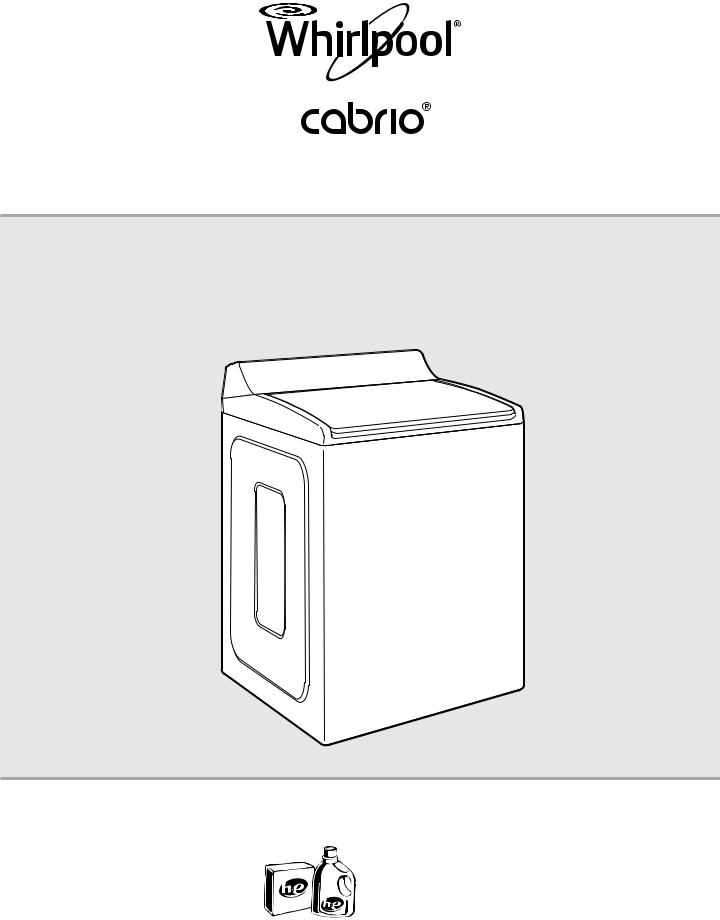
Use & Care Guide
Guide d’utilisation et d’entretien
Top-Loading High Efficiency Low-Water Washer Laveuse haute efficacité à faible consommation d’eau avec chargement par le dessus
Para obtener acceso al Manual de uso y
cuidado en español, o para obtener información adicional acerca de su producto, visite: www.whirlpool.com.
If you have any problems or questions, visit us at www.whirlpool.com
Pour tout problème ou toute question, consulter www.whirlpool.ca
Designed to use only HE High Efficiency detergents.
Conçue pour l’utilisation d’un détergent haute efficacité seulement.
W10607424B W10607425B - SP
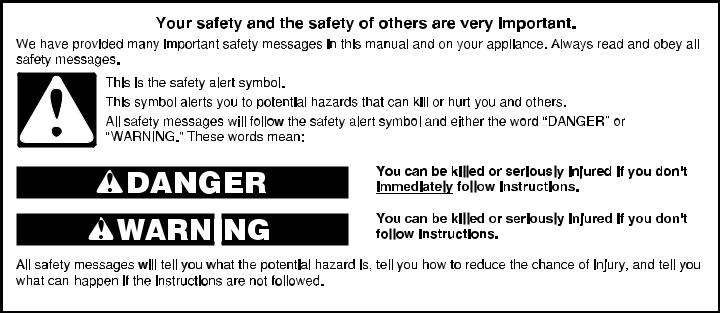
Table of Contents |
|
Table des matières |
|
|
WASHER SAFETY............................................................. |
2 |
SÉCURITÉ DE LA LAVEUSE.......................................... |
|
21 |
WHAT’S NEW UNDER THE LID?..................................... |
4 |
QUOI DE NEUF SOUS LE COUVERCLE? .................... |
22 |
|
CONTROL PANEL AND FEATURES............................... |
5 |
TABLEAU DE COMMANDE |
|
|
Dispensers........................................................................... |
7 |
ET CARACTÉRISTIQUES .............................................. |
|
23 |
CYCLE GUIDE................................................................... |
8 |
Distributeurs...................................................................... |
|
25 |
USING YOUR WASHER................................................... |
9 |
GUIDE DES PROGRAMMES.......................................... |
|
26 |
WASHER MAINTENANCE................................................... |
13 |
UTILISATION DE LA LAVEUSE..................................... |
|
28 |
TROUBLESHOOTING........................................................... |
15 |
ENTRETIEN DE LA LAVEUSE............................................ |
|
32 |
WARRANTY............................................................................ |
20 |
DÉPANNAGE.......................................................................... |
|
34 |
ASSISTANCE OR SERVICE.............................. |
Back Cover |
GARANTIE............................................................................... |
|
42 |
|
|
ASSISTANCE OU SERVICE................. |
Couverture arrière |
|
Washer Safety
2
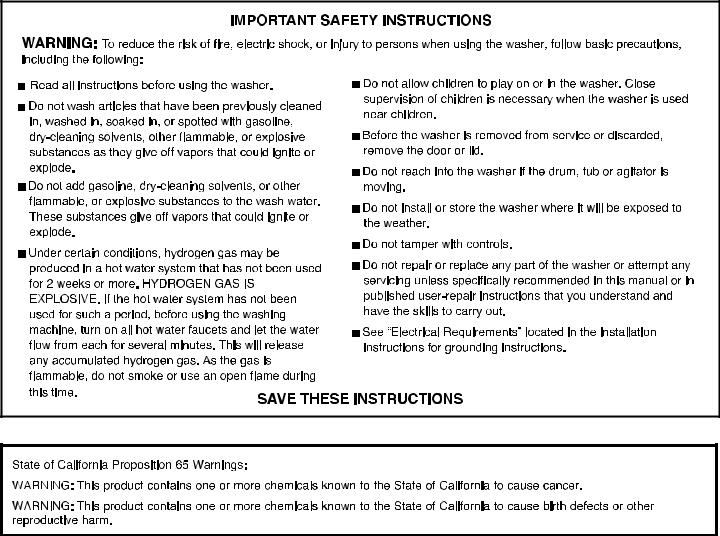
3
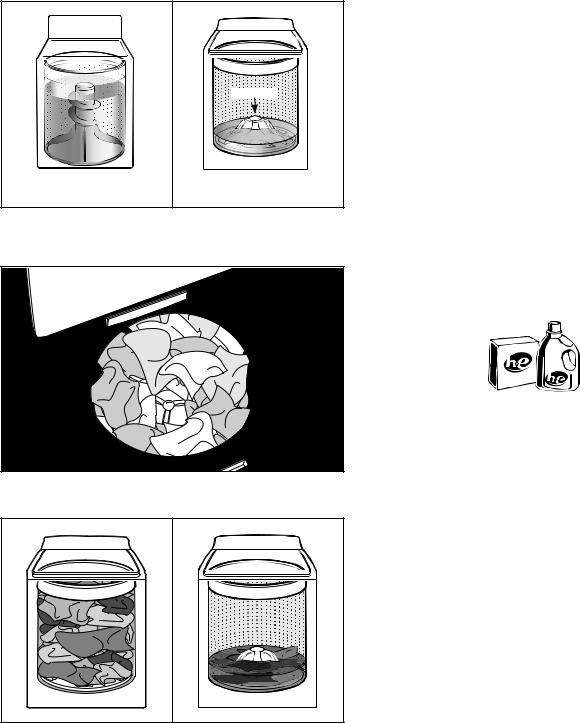
What’s New Under the Lid?
Cleaning with Less Water
|
Washplate |
Traditional agitator-style |
Low-water washer |
washer |
|
The most striking difference in your new washer is the low-water washplate wash system. The washer automatically adjusts the water level to the load size—no water level selector is needed.
For best performance, it is recommended to load items in loose heaps evenly around the washplate.
As the washer dampens and moves the load, the level of the items will settle in the basket. This is normal and does not indicate that more items should be added.
IMPORTANT: You will not see a washer basket full of water as with your past agitator-style washer. It is normal for some of the load to be above the water line.
Automatic Load Size Sensing
Once you start the cycle, the lid will lock, and the washer will begin the sensing process to determine the correct water level for the load.
Initially the basket will start to spin prior to adding water, this is part of the sensing process and is normal. This low-water wash method uses less water and energy compared to a traditional agitator-style washer.
Choosing the Right Detergent
Use only High Efficiency detergents. The package will be marked “HE” or “High Efficiency.” Low-water washing creates excessive sudsing with a regular non-HE detergent. Using regular detergent will likely result in longer cycle times and reduced rinsing performance. It may also result in component failures and noticeable mold or mildew. HE detergents are made to produce the right amount of suds for the best performance. Follow the manufacturer’s instructions to determine the amount of detergent to use, and do not go over the Max line. See “Using Laundry Product Dispensers” for more information.
Use only High Efficiency (HE) detergent.
Improved Cleaning
Low-water cleaning means concentrated cleaning. Rather than diluting detergent as done in an agitator-style washer, this washer delivers the detergent directly to the soils. This low water wash also allows the clothing to move in a more effective way to remove soils.
Normal Sounds You Can Expect
At different stages of the wash cycle, you may hear sounds and noises that are different from those of your previous washer. For example, you may hear a clicking and hum at the beginning of the cycle as the lid lock goes through a self-test. There will be different kinds of humming and whirring sounds as the washplate moves the load and as basket is slowing down to stop. And sometimes, you may hear nothing at all as the washer determines the correct water level for your load or allows time for clothes to soak.
4
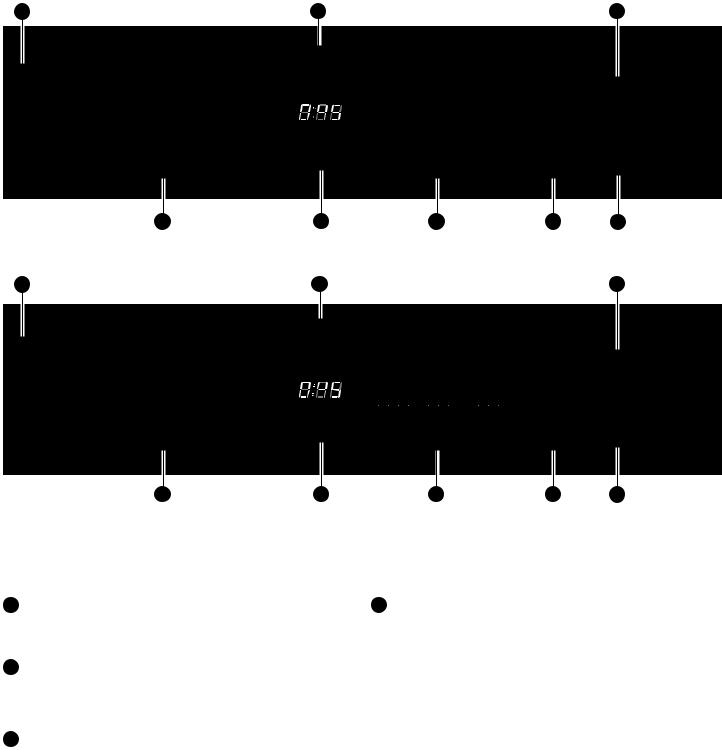
Control Panel and Features
Not all features and cycles are available on all models.
STEAM MODEL
1 |
2 |
3 |
5 |
4 |
6 |
5 |
7 |
NON-STEAM MODEL
1 |
2 |
3 |
5 |
4 |
6 |
5 |
7 |
NOTE: The control panel features a sensitive surface that responds to a light touch of your finger. To ensure your selections are registered, touch the control panel with your finger tip, not your fingernail. When selecting a setting or option, simply touch its name until the desired section is illuminated.
1POWER BUTTON
Touch to turn the washer On. Touching once while the washer is on will cancel the current cycle, touching twice will turn the washer Off.
2WHAT TO WASH/HOW TO WASH
First select a cycle from the “What to Wash” and then select the “How to Wash” to get the best combination cycle available for the type of items you are going to wash. See “Cycle Guide” for cycle details.
3START/PAUSE BUTTON
Touch and hold START/PAUSE to begin the selected cycle; touch again to pause a cycle.
4LED TIME/STATUS DISPLAY
The Estimated Time Remaining display shows the time required for the cycle to complete. Factors such as load size and water pressure may affect the time shown in the display. Tightly packed loads, unbalanced loads, or excessive suds may cause the washer to adjust the cycle time, as well.
If you have set a delay start to the cycle, the Estimated Time Remaining display will show the delay time adjusted.
When the cycle is complete, the Done indicator will light until the lid is opened.
ADD GARMENT
When Add Garment is lit, you may pause the washer, open the lid, and add items. Touch and hold START to start the washer again.
5

5OPTIONS
You may add or remove options for each cycle. Not all options can be used with all cycles, and some are preset to work with certain cycles.
DELAY START
Touch Delay Start to delay the start of the wash cycle up to 12 hours “12H”. Touch Delay Start until a “0H” appears in the status display to turn off, or touch POWER.
END BEEP
Use this to turn the signal indicating the end of a wash cycle to low, medium, high, or off.
NOTE: You may also adjust the tones that sound when a feature, setting, or option is touched. Touch and hold End Beep for about 3 seconds to turn key activation sounds to low, medium, high or off.
STEAM CLEAN (depending on model)
The Steam Clean option adds additional soak and wash time to many cycles to help remove tough stains, as well as a steam boost for added cleaning power. Steam Clean uses a heater within the washer to maintain the selected temperature setting throughout the wash period. Steam Clean may be selected as an option with other cycles.
DEEP CLEAN (depending on model)
This option provides enhanced cleaning action for tough stains. It will add additional agitation and soak time to the cycle.
CLEAN BOOST (depending on model)
This option provides enhanced cleaning action for tough stains. It will add additional agitation and soak time to the cycle.
UTILITY TOOLS
Clean Washer
Use this every 30 washes to keep the inside of your washer fresh and clean. This cycle uses a higher water level. Use with affresh® Washer Cleaner tablet or liquid chlorine bleach to thoroughly clean the inside of your washer. This cycle should not be interrupted. See “Washer Care.”
IMPORTANT: Do not place garments or other items in the washer during the Clean Washer cycle. Use this cycle with an empty wash tub.
Rinse & Spin
Combines a rinse and high speed spin for loads requiring an additional rinse cycle or to complete a load after power interruption. Also use for loads that require rinsing only.
EXTRA RINSE
This option can be used to automatically add a second rinse to most cycles.
PRESOAK
Use this option to add an extra soak period to any cycle to help loosen tough stains. The washer will fill and then pause to soak, and then begin the selected cycle.
6CYCLE MODIFIERS
When you select a cycle, its default settings or the previous cycle selection used will light up.
TEMPERATURE
Temperature Control senses and maintains uniform water temperatures by regulating incoming hot and cold water.
Select a wash temperature based on the type of fabric and soils being washed. For best results and following the garment label instructions, use the warmest wash water safe for your fabric.
•On some models and cycles, warm and hot water will be cooler than what your previous washer provided.
•Even for cold wash settings, some warm water may be added to the washer to maintain a minimum temperature.
SOIL LEVEL
Soil Level (wash time) is preset for each wash cycle.
As you touch the Soil Level pad, the cycle time (minutes) will increase or decrease in the Estimated Time Remaining display and a different wash time will appear.
Select the most suitable setting for your load. For heavily soiled items, select Heavy Soil Level for more wash time. For lightly soiled items, select Light Soil Level for less wash time. Lighter soil level setting will help reduce tangling and wrinkling.
SPIN SPEED
This washer automatically selects the spin speed based on the cycle selected. The preset speeds can be
changed. Not all spin speeds are available with all cycles.
•Faster spin speeds mean shorter dry times, but may increase wrinkling in your load.
•Slower spin speeds mean less wrinkling, but will leave your load more damp.
7 LID
The Lid Lock (

 ) indicator lights up when the lid is locked and cannot be opened. If you need to open the lid, touch and hold START/PAUSE. The lid will unlock once the washer movement has stopped. This may take several minutes if the load was spinning at
) indicator lights up when the lid is locked and cannot be opened. If you need to open the lid, touch and hold START/PAUSE. The lid will unlock once the washer movement has stopped. This may take several minutes if the load was spinning at
high speed. Touch and hold START/PAUSE button again to restart the cycle.
6
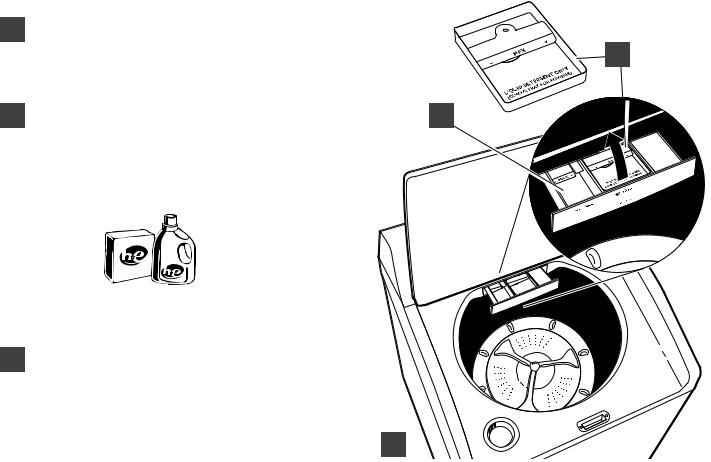
Dispensers
A |
Liquid fabric softener dispenser |
|
|
Pour measured liquid fabric softener into the liquid fabric |
B |
|
softener dispenser if desired. It will dispense automatically |
|
|
at the optimum time. |
|
• Use only liquid fabric softener in this dispenser.
B High Efficiency “HE” detergent dispenser |
A |
Add liquid or powdered HE detergent product to this dispenser for your main wash cycle. Remove tray if using powder detergent.
IMPORTANT: Make sure tray is in drawer when using liquid detergent and removed when using powder detergent and do not go over the Max line.
Use only High Efficiency (HE) detergent.
NOTE: Follow the manufacturer’s instructions to determine the amount of detergent to use.
C Liquid chlorine bleach dispenser
This dispenser holds up to 3/4 cup (180 mL) liquid chlorine bleach. The bleach will be automatically diluted and dispensed at the optimum time during the wash cycle. This dispenser cannot dilute powdered bleach.
NOTE: Fill dispenser with only liquid bleach.
C
7

Cycle Guide
The Whirlpool® Cabrio® washer, has a unique user interface to help you select the best cycle you need for your load. The “What to Wash” “How to Wash” layout guides you to the optimal cycle in two easy steps:
First determine what items are in the load that you are trying to wash. Use that to guide your “What to Wash” selection. Then determine how you want the washer to wash them and select the appropriate “How to Wash” selection. See chart below for more details.
For best fabric care, choose the cycle that |
|
|
|
How do you want to wash? |
|
||
best fits the load being washed. |
|
|
|
|
|
|
|
|
|
“How to Wash” Cycle Selection |
|
||||
R - Recommended Cycle |
|
|
|
|
|||
|
|
|
|
|
|
|
|
a - Alternate Cycle |
|
Normal |
Quick |
|
Cold |
Deep Water |
ColorLast |
|
|
|
|
|
|
|
|
Blank – Cycle is available but not optimal. |
• Powerful Soil |
• Fast |
|
• Saving Water |
• with Extra Water |
• Protecting my colors |
|
|
|
Removal |
|
|
& Energy |
• “Conventional |
• Protecting my fabrics |
|
|
• Regular |
|
|
• Cold Wash |
Style” More Water |
• Gentle cleaning |
|
|
|
|
|
|
|
|
What do you |
“What to Wash” |
|
|
|
|
|
|
want to wash? |
Cycle Selection |
|
|
|
|
|
|
Athletic/High |
|
R |
a |
|
a |
a |
a |
Performance Wear |
|
|
|
|
|
|
|
Bright Colors |
|
|
|
|
a |
|
R |
|
|
|
|
|
|
|
|
Cottons/Linens |
|
R |
|
|
|
|
|
|
|
|
|
|
|
|
|
Dark Colors |
|
|
|
|
a |
|
R |
|
|
|
|
|
|
|
|
Jeans |
Mixed |
R |
a |
|
a |
a |
|
|
|
|
|
|
|
|
|
Pajamas |
|
R |
a |
|
a |
a |
a |
Sweatshirts |
|
R |
a |
|
a |
a |
a |
Terry Cloth |
|
R |
a |
|
|
a |
|
|
|
|
|
|
|
|
|
Towels |
|
R |
a |
|
|
a |
|
|
|
|
|
|
|
|
|
T-Shirts |
|
R |
a |
|
a |
a |
a |
Business Casual |
|
R |
a |
|
a |
a |
a |
|
|
|
|
|
|
|
|
Dress Shirts/Pants |
Casuals |
R |
a |
|
a |
a |
a |
|
|
|
|
|
|
|
|
Linens |
R |
a |
|
a |
a |
a |
|
|
|
||||||
|
|
|
|
|
|
|
|
No-Iron Fabrics |
|
R |
a |
|
a |
a |
a |
Baby Clothes |
|
R |
|
|
|
a |
|
|
|
|
|
|
|
|
|
Dish Cloths |
|
R |
a |
|
|
a |
|
|
|
|
|
|
|
|
|
Handkerchiefs |
|
R |
a |
|
|
a |
|
Napkins |
|
R |
a |
|
|
a |
|
|
|
|
|
|
|
|
|
Socks |
Whites |
R |
a |
|
|
a |
NA |
Tablecloth |
R |
a |
|
a |
a |
||
Undergarments |
|
R |
a |
|
|
a |
|
White Clothing |
|
R |
a |
|
a |
a |
|
White Shirts |
|
R |
a |
|
a |
a |
|
White Towels |
|
R |
a |
|
|
a |
|
|
|
|
|
|
|
|
|
White T-Shirts |
|
R |
a |
|
a |
a |
|
Bras |
|
R |
a |
|
a |
a |
a |
|
|
|
|
|
|
|
|
Handwash Fabrics |
|
R |
a |
|
a |
a |
a |
Lingerie |
Delicates |
R |
a |
|
a |
a |
a |
Machine Wash Silks |
|
R |
a |
|
a |
a |
a |
|
|
|
|
|
|
|
|
Wool |
|
R |
a |
|
a |
a |
a |
Blankets |
|
a |
a |
|
a |
R |
|
|
|
|
|
|
|
|
|
Coats & Jackets |
|
R |
a |
|
a |
a |
a |
Comforters |
|
a |
a |
|
a |
R |
|
|
|
|
|
|
|
|
|
Machine Wash Curtains |
Bulky/Sheets |
R |
a |
|
a |
a |
a |
Machine Wash Slip Covers |
R |
a |
|
a |
a |
|
|
|
|
|
|||||
|
|
|
|
|
|
|
|
Non-Rubber Lined Rugs |
|
R |
a |
|
a |
a |
|
& Mats |
|
|
|
||||
|
|
|
|
|
|
|
|
Sheets |
|
R |
a |
|
|
a |
a |
|
|
|
|
|
|
|
|
Sleeping Bags |
|
a |
a |
|
a |
R |
|
|
|
|
|
|
|
|
|
8
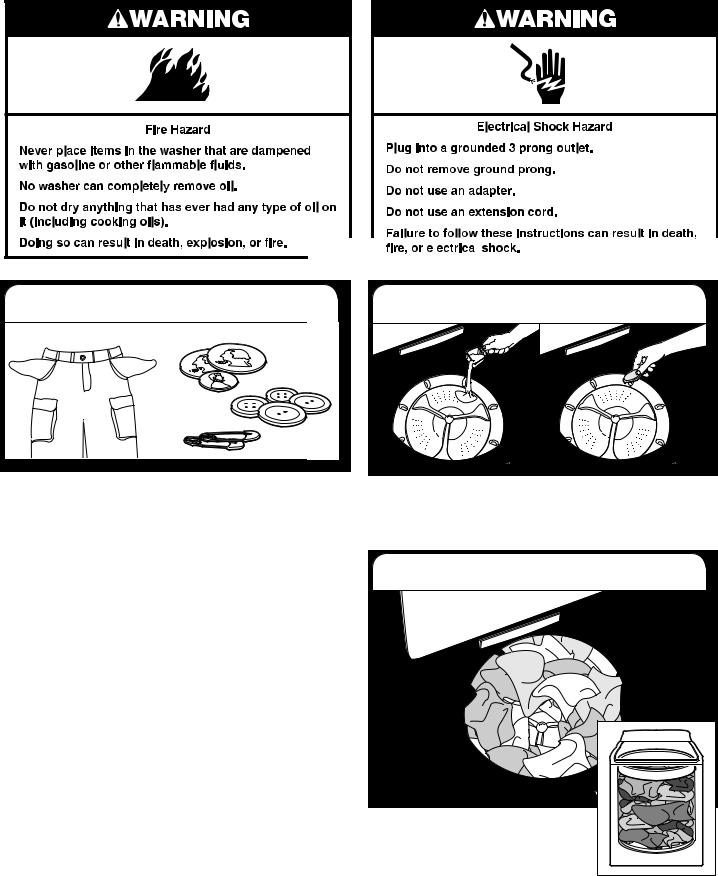
Using Your Washer
1. Sort and prepare your laundry
2. Add laundry products
•Empty pockets. Loose change, buttons, or any small object can pass under the washplate and become trapped, causing unexpected sounds.
•Sort items by recommended cycle, water temperature, and colorfastness.
•Separate heavily soiled items from lightly soiled.
•Separate delicate items from sturdy fabrics.
•Do not dry items if stains remain after washing; heat can set stains into fabric.
•Treat stains promptly.
•Close zippers, fasten hooks, tie strings and sashes. Remove non-washable trim and ornaments.
•Mend rips and tears to avoid further damage to items during washing.
Helpful Tips:
•For best performance, use HE liquid detergent when washing bulky items.
•When washing water-proof or water-resistant items, load evenly.
•Use mesh bags to help avoid tangling when washing delicate or small items.
•Turn knits inside out to avoid pilling. Separate lint-takers from lint-givers. Synthetics, knits, and corduroy fabrics will pick up lint from towels, rugs, and chenille fabrics.
NOTE: Always read and follow fabric care labels instructions to avoid damage to your items.
Single-dose laundry packet, color-safe bleach, Oxi-type boosters, or fabric softener crystals can be added to the basket prior to adding laundry.
NOTE: Always follow manufacturer’s instructions.
3. Load laundry into washer |
For best performance, load items in loose heaps evenly around the washplate. Try mixing different sized items to reduce tangling.
IMPORTANT: Items need to move freely
for best cleaning and to reduce wrinkling and tangling.
9
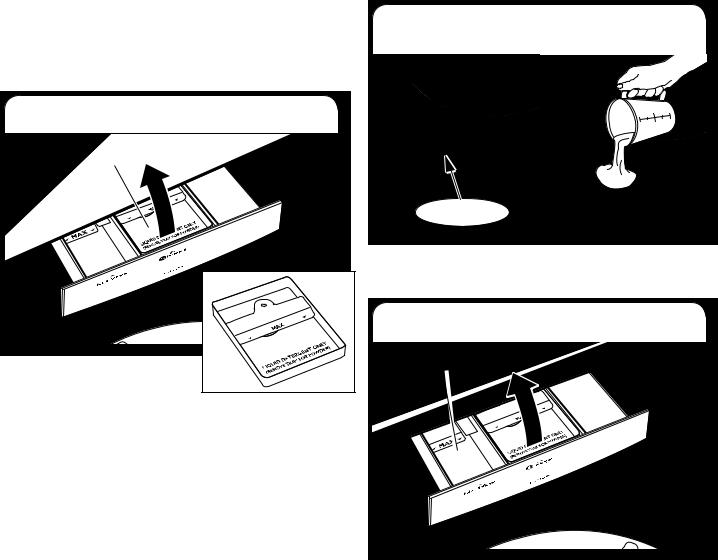
Using Laundry Product Dispensers
NOTE: Do not add single-dose laundry packets, color-safe bleach, Oxi-type boosters, or fabric softener crystals to dispensers. They will not dispense correctly. Add to the basket prior to adding laundry.
4. Add HE detergent
HE removable |
detergent tray |
Add a measured amount of HE detergent into detergent tray. This
tray holds 3 oz. (89 mL). If adding
powder HE detergent remove inside tray. Do not overfill tray
– adding too much detergent may cause detergent to be dispensed into the washer too early.
NOTE: Make sure tray is in drawer when using liquid detergent and removed when using powder detergent. Do not go over the Max line.
IMPORTANT: Use only High Efficiency detergents. The package will be marked “HE” or “High Efficiency.” Low-water washing creates excessive sudsing with a regular non-HE detergent. Using regular detergent will likely result in longer cycle times and reduced rinsing performance. It may also result in component failures and noticeable mold or mildew. HE detergents are made to produce the right amount of suds for the best performance. Follow the manufacturer’s instructions to determine the amount of detergent to use.
HELPFUL TIP: See “Washer Maintenance” for information on recommended method of cleaning washer dispenser trays.
5. Add liquid chlorine bleach to dispenser
Liquid
Chlorine Bleach
Do not overfill, dilute, or use more than 1 cup (250 mL). Do not use color-safe bleach or Oxi products in the same cycle with liquid chlorine bleach.
6. Add liquid fabric softener
Fabric softener tray
Pour a measured amount of liquid fabric softener into tray; always follow manufacturer’s directions for correct amount of fabric softener based on your load size. Close dispenser drawer. Fabric Softener is added during rinse.
IMPORTANT: Do not overfill or dilute. Overfilling dispenser will cause fabric softener to immediately dispense into washer.
If Extra Rinse option is selected, fabric softener will be dispensed into the last rinse.
It is normal for a small amount of water to remain in the dispenser at the end of a cycle.
10
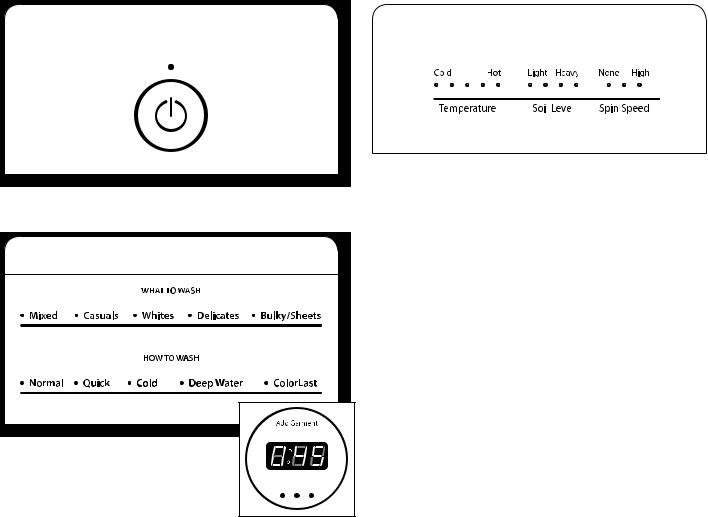
7. Touch POWER to turn on washer |
|
9. Select cycle modifiers |
|||||
|
|
|
|
|
|
|
|
|
|
|
|
|
|
|
|
|
|
|
|
|
|
|
|
|
|
|
|
|
|
|
|
|
|
|
|
|
|
|
|
|
|
|
|
|
|
|
|
|
|
|
|
|
|
|
|
|
|
|
|
|
|
|
|
Make sure the dispenser drawer is closed completely, then touch POWER to turn on the washer.
8. Select type of load to wash
First touch a cycle from the “What to Wash” and then select the “How to Wash” to get the best combination cycle available
for the type of items you are going to wash. See “Cycle Guide” for cycle details. Red, green, and blue LED lights come on below the time/status display when the “How to Wash” ColorLast cycle is selected. Not all cycles are available on all models.
Estimated Time Remaining will light up with a cycle time. You may notice time adjusting during the cycle. This is normal.
If you do not want to begin a cycle immediately, you may choose DELAY START option.
To choose a delay time:
1.Touch DELAY START button to select desired delay time. Time will increase in hour increments up to 12 hours.
2.Touch and hold START/PAUSE button to start delay start time.
IMPORTANT: When delaying a cycle, use liquid HE detergent only in the dispenser. Powdered detergents may absorb moisture from a previous cycle and clump before the wash cycle begins.
To cancel delay start:
1.Touch POWER to cancel Delay Start.
To pause delay start:
1.Touch START/PAUSE button to pause delay start.
2.Touch and hold START/PAUSE button again to start Delay Start time. If the delay start time is not started after 10 minutes the washer will power off.
Once you select a cycle, the default modifiers or the previous set modifiers for that cycle will be lit. Touch the cycle settings buttons to change the Soil Level, Spin Speed, and Temperature, if desired. Not all settings are available with all cycles.
NOTE: Always read and follow fabric care labels instructions to avoid damage to your items.
Temperature |
Suggested Fabrics |
|
|
|
|
Hot |
|
|
Some cold water is added |
Whites and pastels |
|
to save energy. This will be |
Durable items |
|
cooler than your hot water |
||
Heavy soils |
||
heater setting |
||
|
||
|
|
|
Warm |
|
|
Some cold water will be |
Bright colors |
|
added, so this may be cooler |
Moderate to light soils |
|
than what your previous |
||
|
||
washer provided. |
|
|
|
|
|
Cool |
|
|
Warm water is added to assist |
Colors that bleed or fade |
|
in soil removal and to help |
Light soils |
|
dissolve detergents. |
||
|
||
|
|
|
Cold |
|
|
Warm water may be added to |
Dark colors that bleed or fade |
|
assist in soil removal and to |
Light soils |
|
help dissolve detergents. |
||
|
||
|
|
11

10. Select cycle options
Steam Model
Select any other cycle options you may wish to add, if not previously set. Some cycles will automatically add certain options such as Extra Rinse. These may be turned off if desired.
NOTE: Not all options are available with all cycles. Touch control panel to select any other options.
11. Touch and hold START/PAUSE button to begin wash cycle
Touch and hold START/PAUSE button to start the wash cycle. When the cycle has finished, the end of cycle signal will sound (if set). Promptly remove items when cycle is done to avoid odor, reduce wrinkling, and rusting of metal hooks, zippers, and snaps.
Unlocking the lid to add items
If you need to open the lid to add 1 or 2 missed items:
Touch START/PAUSE button to pause washer; the lid will unlock once the washer movement has stopped. This may take several minutes if the load was spinning at a high speed. Then close lid and touch and hold START/PAUSE button again to restart the cycle.
IMPORTANT: If lid is left open for more than 10 minutes the water will pump out and F8E6 error code will appear
on the display.
12
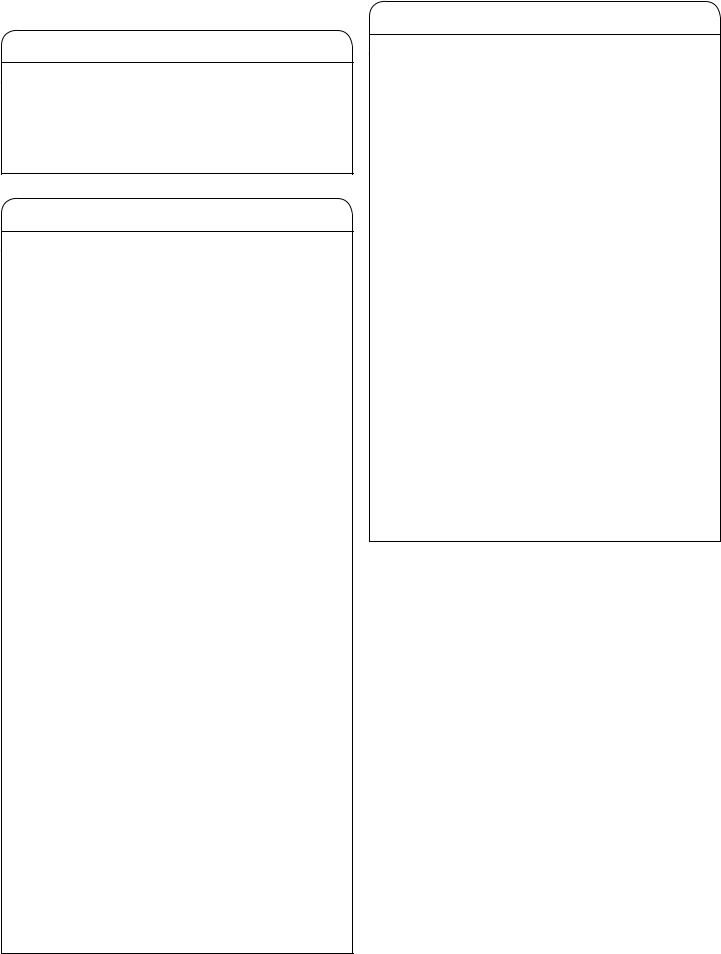
Washer Maintenance
WATER INLET HOSES
Replace inlet hoses after 5 years of use to reduce the risk of hose failure. Periodically inspect and replace inlet hoses if bulges, kinks, cuts, wear, or leaks are found.
When replacing your inlet hoses, mark the date of replacement on the label with a permanent marker.
NOTE: This washer does not include inlet hoses. See the Installation Instructions for more information.
WASHER CARE
Recommendations to Help Keep Your Washer Clean and Performing at its Best
1.Always use High Efficiency (HE) detergents and follow the HE detergent manufacturer’s instructions regarding the amount of HE detergent to use. Never use more than the recommended amount because that may increase the rate at which detergent and soil residue accumulate inside your washer, which in turn may result in undesirable odor.
2.Use warm and hot wash water settings sometimes (not exclusively cold water washes), because they do a better job of controlling the rate at which soils and detergent accumulate.
3.Always leave the washer lid open between uses to help dry out the washer and prevent the buildup of odor-causing residue.
Cleaning Your Top Loading Washer
Read these instructions completely before beginning the routine cleaning processes recommended below. This Washer Maintenance Procedure should be performed, at a minimum, once per month or every 30 wash cycles,
whichever occurs sooner, to control the rate at which soils and detergent may otherwise accumulate in your washer.
Cleaning the Inside of the Washer
To keep your washer odor-free, follow the usage instructions provided above, and use this recommended monthly cleaning procedure:
Clean Washer Cycle
This washer has a special cycle that uses higher water volumes in combination with affresh® Washer Cleaner
or liquid chlorine bleach to clean the inside of the washer.
Begin procedure
1.affresh® Washer Cleaner Cycle Procedure (Recommended for Best Performance):
a.Open the washer lid and remove any clothing or items.
b.Place an affresh® Washer Cleaner tablet in the bottom of the washer basket.
c.Do not place an affresh® Washer Cleaner tablet in the detergent dispenser.
d.Do not add any detergent or other chemical to the washer when following this procedure.
e.Close the washer lid.
f.Select the CLEAN WASHER cycle.
g.Touch and hold the START/PAUSE button to begin the cycle. The Clean Washer Cycle Operation is described below.
NOTE: For best results, do not interrupt cycle. If cycle must be interrupted, touch POWER. After the Clean Washer cycle has stopped, run a Rinse & Spin cycle to rinse cleaner from washer.
WASHER CARE (cont.)
2.Chlorine Bleach Procedure (Alternative):
a.Open the washer lid and remove any clothing or items.
b.Add 1 cup (236 mL) of liquid chlorine bleach to the bleach compartment.
NOTE: Use of more liquid chlorine bleach than is recommended above could cause washer damage over time.
c.Close the washer lid.
d.Do not add any detergent or other chemical to the washer when following this procedure.
e.Select the CLEAN WASHER cycle.
f.Touch and hold the START/PAUSE button to begin the cycle. The Clean Washer Cycle Operation is described below.
NOTE: For best results, do not interrupt cycle. If cycle must be interrupted, touch POWER. After the Clean Washer cycle has stopped, run a Rinse & Spin cycle to
rinse cleaner from washer.
Description of Clean Washer Cycle Operation:
1.This cycle will fill to a water level higher than in normal wash cycles to provide rinsing at a level above the water line for normal wash cycle.
2.During this cycle, there will be some agitation and spinning to increase the removal of soils.
After this cycle is complete, leave the lid open to allow for better ventilation and drying of the washer interior.
Cleaning the Outside of the Washer
Use a soft, damp cloth or sponge to wipe away any spills. Use only mild soaps or cleaners when cleaning external washer surfaces.
IMPORTANT: To avoid damaging the washer’s finish, do not use abrasive products.
13
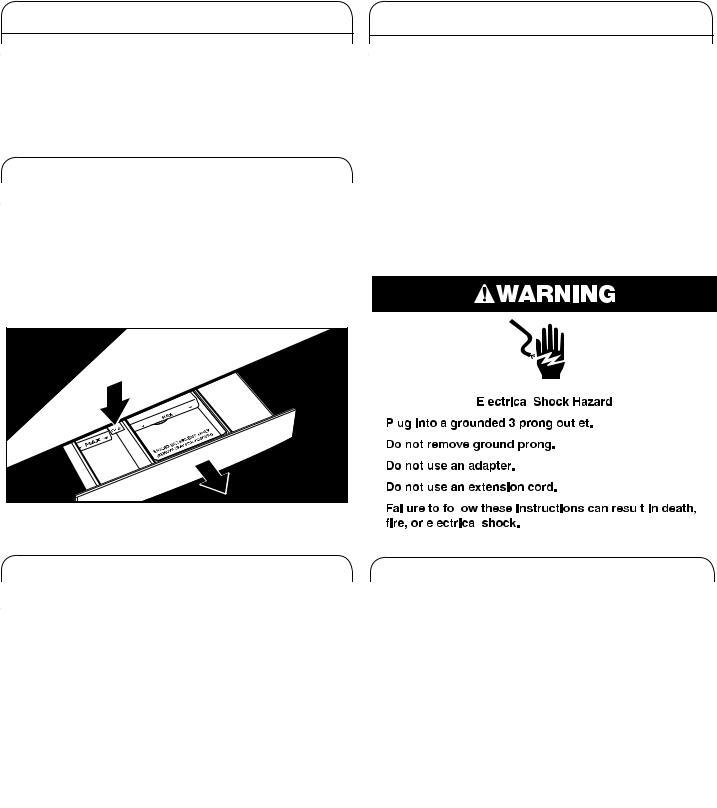
NON-USE AND VACATION CARE
Operate your washer only when you are home.
If moving, or not using your washer for a period of time, follow these steps:
1.Unplug or disconnect power to washer.
2.Turn off water supply to washer, to avoid flooding due to water pressure surge.
CLEANING YOUR DISPENSER
You may find laundry product residue leftover in your dispenser drawer. To remove residue, follow this recommended cleaning procedure:
1.Pull drawer out until you feel resistance.
2.Push 1 tab downward, and then continue pulling out.
3.Wash in warm, soapy water, using a mild detergent.
4.Rinse with warm water.
5.Air dry, or dry with a towel, then place back into slot.
IMPORTANT: Dispenser drawer and tray are not dishwasher safe.
WINTER STORAGE CARE
IMPORTANT: To avoid damage, install and store washer where it will not freeze. Because some water may stay in hoses, freezing can damage washer. If storing or moving during freezing weather, winterize your washer.
To winterize washer:
1.Shut off both water faucets; disconnect and drain water inlet hoses.
2.Put 1 qt. (1 L) of R.V.-type antifreeze in basket and run washer on RINSE & SPIN cycle for about
30 seconds to mix antifreeze and remaining water.
3.Unplug washer or disconnect power.
TRANSPORTING YOUR WASHER
1.Shut off both water faucets. Disconnect and drain water inlet hoses.
2.If washer will be moved during freezing weather, follow WINTER STORAGE CARE directions before moving.
3.Disconnect drain from drain system.
4.Unplug power cord.
5.Place inlet hoses inside washer basket.
6.Drape power cord and drain hose over the console and secure with masking tape.
7.Place foam packing ring from original shipping materials back inside washer. If you do not have packing ring, place heavy blankets or towels into basket opening. Close lid and place tape over lid and down front of washer. Keep lid taped until washer is placed in
new location. Transport Washer in the upright possition.
REINSTALLING/USING WASHER AGAIN
To reinstall washer after non-use, vacation, winter storage or moving:
1.Refer to Installation Instructions to locate, level, and connect washer.
2.Before using again, run washer through the following recommended procedure:
To use washer again:
1.Flush water pipes and hoses. Reconnect water inlet hoses. Turn on both water faucets.
2.Plug in washer or reconnect power.
3.Run washer through Bulky/Sheets and Deep Water Wash cycle to clean washer and remove antifreeze, if used. Use only HE High Efficiency detergent. Use half the manufacturer’s recommended amount for a medium-size load.
14
